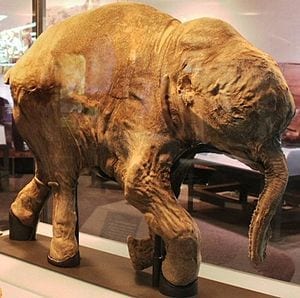
As an ecologist of ice age giants, I long ago came to terms with the fact that I will never look my study organisms in the eye.
I will never observe black-bear-sized beavers through binoculars in their natural habitats, build experimental exclosures to test the effects of mastodons on plants, or even observe a giant ground sloth in a zoo.
As a conservation paleoecologist, I study the natural experiments of the past—like climate change and extinction—to better understand the ecology of a warming, fragmented world. Admitedly, part of the appeal of the ice age past is the challenge of reconstructing long-disappeared landscapes from fragments like pollen, tiny fragments of charcoal, and bits of leaves preserved in lakes. In the absence of mammoths, for example, I rely instead on spores of fungi that once inhabited their dung.
De-extinction could change that. On Friday, a group of geneticists, conservationists, journalists, and others convened in Washington, D.C. to discuss resurrecting extinct species, including the woolly mammoth. De-extinction sounds like science fiction, but it’s rooted in very real conservation concerns. With the sequencing of the woolly mammoth genome complete and recent advancements in biotechnology, the question of whether to clone extinct species like mastodons, dodos, or the Shasta ground sloth is rapidly becoming more of a question of should, rather than how. The latter isn’t straightforward, and involves the integration of a number of cutting edge disciplines, but I’d like to focus on the former: should we clone woolly mammoths?
A growing problem I’ve had (and one which Brian Switek raises in a recent post at National Geographic) is that the de-extinction proposals are Big Ideas, but they they’re often shallow when it comes to ecology. Even the concept of “de-extinction” itself is misleading. Successfully cloning an animal is one thing; rescuing it from the black hole-like pull of extinction is another. Decades of conservation biology research has tried to determine the careful calculus of how many individuals and how much land are needed for a species to survive without major intervention, accounting for its needs for food, habitat, and other resources.
Mammoths have been extinct on continents for over ten thousand years (though dwarf versions survived into the time of the ancient Egyptians on isolated Arctic islands). Even so, the fossil record has yielded rich clues about ecology. All ethical considerations aside, from a conservation biology standpoint, what does it mean to be a mammoth?
The Latest Bing News on:
Cloning Woolly Mammoths
- What It Will Take to Create 21st-Century Mammoths, Dodos, and Thylacineson May 4, 2024 at 9:00 pm
Colossal Biosciences has generated a flurry of headlines in recent years, as the ‘de-extinction’ company announced plans to resurrect the woolly mammoth, the Tasmanian tiger, and, most recently, the ...
- Science Seeks to Resurrect Woolly Mammoth in Yellowstone by 2028on April 29, 2024 at 8:04 am
That line resonates today, as news broke that a biotech firm called Colossal Biosciences has announced its intentions to bring the Woolly Mammoth back to life and reintroduce it to its pre-historic ...
- Bringing back the woolly mammoth to roam Earth again. Is it even possible? | The Excerpton April 17, 2024 at 5:00 pm
Could the woolly mammoth return? Ben Lamm thinks so ... and the way that we think about that is you're not making a clone of that extinct species. So there's a lot of computational analysis ...
- What ‘de-extinction’ of woolly mammoths can teach us: a Q&A with evolutionary biologist Beth Shapiroon April 3, 2024 at 5:00 pm
Related: Giant sloths and woolly mammoths ... “I’m going to clone a mammoth.” But in order to clone a mammoth, you need a living cell. You need an intact nuclear genome of a mammoth ...
- Reviving the Ice Age - U.S. Scientists Clone Mammoths to Combat Climate Changeon March 12, 2024 at 2:37 am
A world where woolly mammoths are brought back to life through science and technology and trample through nature sounds more like something from "Jurassic Park." Yet a scientific breakthrough ...
- Woolly Mammoth: The Autopsyon May 21, 2023 at 8:34 pm
Can cloning bring mammoths back from extinction? This documentary follows a team of mammoth specialists and cloning scientists as they dissect the best-preserved mammoth ever found. Advertisement ...
- Siberia Is Allegedly Home to Surviving Woolly Mammothson May 4, 2023 at 7:16 am
We all recognize the distinct elephantine shape of a woolly mammoth - the shaggy coat ... is working to revive the species through DNA cloning. Love what you're reading? Be sure to follow us ...
- Of Mammoths and Menon December 27, 2022 at 1:15 am
Ancient hunters killed woolly mammoths for their meat ... soft mammoth tissue in hopes of finding viable cells to clone. (See “Bringing Them Back to Life.”) A few years ago this local boss ...
- Woolly Mammothon September 13, 2021 at 10:56 am
The woolly mammoth (Mammuthus primigenius ... It has been proposed the species could be recreated through cloning, but this method is as yet infeasible because of the degraded state of the ...
- Recipe for a Resurrectionon April 21, 2020 at 11:09 am
Talk of cloning surged again a few weeks later when ... Transforming this data into a woolly mammoth will be far trickier, though the existence of close living relatives, the African and Asian ...
The Latest Google Headlines on:
Cloning Woolly Mammoths
[google_news title=”” keyword=”Cloning Woolly Mammoths” num_posts=”10″ blurb_length=”0″ show_thumb=”left”] [/vc_column_text]The Latest Bing News on:
De-extinction
- Bees face extinction due to climate change making it too hot to handleon May 3, 2024 at 6:06 am
Bees face extinction because their nests are overheating due to climate change, warns a new study. Originally published on talker.news, part of the BLOX Digital Content Exchange.
- Congressional Republicans announce resolution to overturn Biden tailpipe ruleon May 1, 2024 at 5:44 pm
Congressional Republicans, led by Sen. Pete Ricketts (R-Neb.) and Rep. John James (R-Mich.), introduced a Congressional Review Act (CRA) resolution Wednesday that would undo the Biden ...
- Where Did the All the Brie Go? French Cheeses on the Verge of Extinctionon May 1, 2024 at 1:03 pm
What if I told you your favorite brie cheese might go extinct soon? Cheesemakers are struggling to keep some French cheeses from disappearing.
- Rare giant otter arrives at zoo to help save species from extinctionon May 1, 2024 at 6:47 am
A rare male giant otter has arrived at Chester Zoo as part of a conservation breeding program in a bid to help save his species from extinction. The three-year-old named Manú has traveled more than ...
- Study shows climate change and mercury pollution stressed plants for millions of yearson April 30, 2024 at 9:34 am
The link between massive flood basalt volcanism and the end-Triassic (201 million years ago) mass extinction is commonly accepted. However, exactly how volcanism led to the collapse of ecosystems and ...
- Woolly Mammoths In Yellowstone? Biotech Company Says It Has The Technologyon April 27, 2024 at 8:58 am
Biotech company Colossal Biosciences has announced plans to bring back the extinct woolly mammoth by 2028. They think Yellowstone could be a good place for reintroduction as the environment is ...
- What It'll Take to Create 21st-Century Mammoths, Dodos, and Thylacineson April 27, 2024 at 8:16 am
We don’t fully understand how to create an artificial placenta at the moment. We don’t really understand the intricacies of the developmental process. This is all information that we will learn along ...
- A rare mammal with a trunk-like snout and webbed feet: The Iberian desman faces extinctionon April 24, 2024 at 7:34 am
The ‘Spanish platypus’ is unique to the Iberian Peninsula and a jewel of evolution that has lost up to 70% of the geographical range it occupied three decades ago ...
- Bringing back the woolly mammoth to roam Earth again. Is it even possible? | The Excerpton April 17, 2024 at 5:00 pm
Lamm joined The Excerpt podcast to talk about the possible impacts and the ongoing ethical debate around de-extinction. Hit play on the player below to hear the podcast and follow along with the ...
- The Tasmanian tiger might be extinct but Aussies are determined to find it or bring it backon April 14, 2024 at 4:32 pm
Pask has raised $15 million for a de-extinction project in partnership with American company Colossal Biosciences, which counts Leonardo DiCaprio, Paris Hilton and even the C.I.A. among its backers.
The Latest Google Headlines on:
De-extinction
[google_news title=”” keyword=”de-extinction” num_posts=”10″ blurb_length=”0″ show_thumb=”left”]









